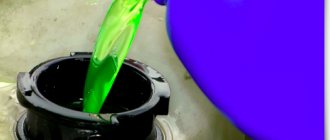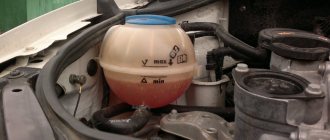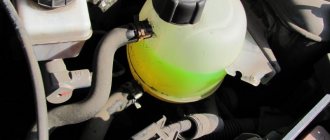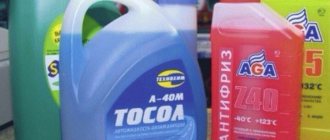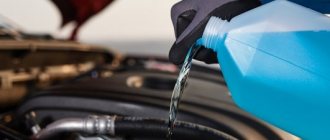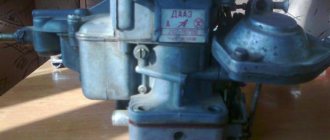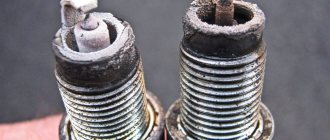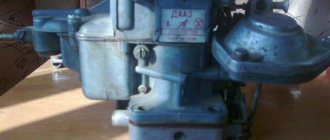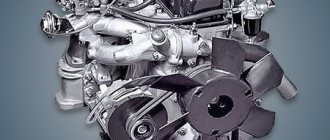Engine operation generates a lot of heat and cooling is necessary for every car. The temperature reduction achieved by air movement will not be enough, and there are special coolants. The functioning of the engine depends on their quality, so it is important to choose the right composition. There are various types of antifreeze available on the market, and you need to know their features.
Coolant
To cool the engine, you need a liquid with modified freezing and boiling values. Such features allow the vehicle to be used in severe winter or abnormal summer conditions. In colloquial vocabulary, all types of coolants are called antifreeze or antifreeze. These names conceal huge differences in composition, which affects their performance.
Antifreeze, like antifreeze, is marked by manufacturers not only by characteristics, but also by color. These features are needed to visually distinguish liquids of different compositions. So, the color of antifreeze can be blue or red, but antifreeze has many more shades. To properly understand their properties, you should study the composition of the refrigerant.
Types of antifreeze
Antifreeze is a refrigerant developed by domestic manufacturers. The liquid is primarily used to ensure the functioning of the cooling system of Russian-made cars.
Today there is a whole range of varieties of antifreeze, differing in freezing temperature and other properties.
TOSOL A-40M
Antifreeze A-40M - developed by domestic manufacturers. Its main component is glycol alcohol.
To give the substance the properties of coolants, manufacturers add up to 10 different additives to it. They prevent foam formation and corrosion.
Antifreeze A-40M is odorless and has a sweetish taste. To make the liquid different from others, it is painted in unnatural colors.
Antifreeze made by Russian manufacturers usually has a blue or light green tint. When using the substance, you must remember that it is very toxic.
Experts advise avoiding getting coolant on your skin. If antifreeze accidentally gets on the car enthusiast’s body, it is necessary to wash off the liquid with plenty of water.
When choosing between different types of coolants, you need to carefully study their properties.
Thus, antifreeze A-40M has the following characteristics:
- has a boiling point of +108 degrees,
- has low viscosity,
- does not have a negative effect on the parts of the cooling system,
- does not freeze at temperatures down to -40 degrees,
- does not foam
- remains chemically stable during operation and storage,
- has high thermal conductivity.
Antifreeze A-40M differs from antifreeze by a set of additives that prevent corrosion. Mixing coolants is prohibited.
The components included in their composition may react, and the properties of the coolant will change.
Antifreeze A-40M is designed for a range of 60,000 km. When the mark is reached, the fluid must be replaced.
If the car owner does not use the vehicle very actively, the antifreeze needs to be changed at least once every 2 years.
Experts advise me to use the liquid used for the same brand. If a car owner plans to change Antifreeze A-40M to another antifreeze, the cooling system must be flushed.
The use of this brand of coolant is associated with a number of positive and negative aspects. Thus, antifreeze A-40M contains additives that protect cast iron, copper, steel, and brass.
However, there are no substances to protect aluminum. This makes the coolant ideal for use in the cooling systems of domestic VAZs, but prevents its use in foreign cars.
In addition, the liquid has a relatively high freezing point. In regions with harsh winters, the use of antifreeze A-40M is not possible.
TOSOL A-65M
Antifreeze A-65M is another type of coolant that is popular among Russian car owners. Coolant is used to cool different types of engines:
- passenger cars,
- freight transport,
- domestically produced cars,
- vehicles manufactured abroad.
The liquid differs from other consumables for the car cooling system in its resistance to sudden temperature changes.
The additives included in antifreeze function perfectly both at +110 and at -65 degrees Celsius. The liquid meets the requirements of the state standard.
It does not have a negative effect on cooling system parts made of rubber and plastic.
The basis of antifreeze A-65M is ethylene glycol. Coolant can be mixed with products of other brands based on the same substance. However, experts advise resorting to action only in extreme cases.
Antifreeze A-65M has the following characteristics:
- crystallization occurs if the temperature drops below – 65 degrees,
- coolant density is 1.085 - 1.100 g/cm3,
- the refrigerant may boil if the temperature rises above +110 degrees,
- foam disappears in no more than 3 s,
- has a hydrogen index of 7.5 - 11.0.
The positive features of this brand of coolant include good thermal qualities. In addition, antifreeze has good lubricating properties. However, the substance is aggressive.
A number of car enthusiasts claim that its use can damage parts of the cooling system.
TOSOL AM (concentrate)
Unlike other coolants, Antifreeze AM-K is not used immediately after purchase. Before pouring liquid into the car’s cooling system, it is first diluted with distilled water.
The main component of Antifreeze AM-K is ethylene glycol. In addition to the main component, the coolant includes:
- water,
- additives that prevent corrosion,
- coloring matter,
- additives that prevent the formation of foam.
Externally, AM-K antifreeze does not differ significantly from other products that ensure the normal functioning of the car’s cooling system.
It is a blue liquid without mechanical impurities. However, AM-K antifreeze has one of the highest freezing temperatures among analogues. Its crystallization occurs already at -35 degrees Celsius. This feature is the main disadvantage of the product. The advantages include its low cost.
| Index | Features of antifreeze AM-K |
| Alkalinity | 10 cm3 |
| Rubber swelling | No more than 5% |
| Refrigerant crystallization temperature | -35 degrees Celsius |
| Product Density | 1.120-1.150 g/cm3 |
| Foaming | No more than 30 cm3 |
| Foam disappearance time | No more than 3 s |
What is antifreeze and antifreeze
Before the advent of coolants, water was used as a coolant. Boiling or freezing in the system made the machine difficult to use, and the automotive industry demanded a more effective solution. The basis of the coolant is a solution of ethylene glycol with distilled water. Organic substances or complex chemical compounds are used as additives. Due to such additives, various properties of the coolant are achieved.
Antifreeze became the first coolant that was widely available. The fuel system of the car required high-quality cooling, and water was poorly suited in terms of its physical and chemical characteristics. The use of ethylene glycol-based fluid greatly simplified the operation of the machine. A low freezing threshold was important in harsh winter conditions, and antifreeze provided an opportunity to experience all the benefits of good cooling.
History of creation
Initially, car owners used ordinary water as a coolant in internal combustion engines, which made it possible to effectively cool the operating power unit. However, such water froze when the first cold weather set in, and scale of calcium and salt deposits formed inside the engine and in the radiator, which led to the need for expensive engine repairs.
In the 50s of the last century, with the development of the automotive industry in the USSR, the need arose to develop a high-quality coolant that would not freeze at temperatures of the order of minus 35 degrees, retain all its properties, be flexible and at the same time not contain any deposits that could precipitate at significant temperatures. increasing temperature inside the engine.
The development of antifreeze was carried out at the Institute of Organic Synthesis Technology, from the abbreviation of which this coolant was named. Subsequently, the abbreviation antifreeze remained unchanged, and the use of various additives and chemical compounds made it possible to significantly improve the performance characteristics, which are maintained throughout the entire service life of this technical fluid.
Application of antifreeze
Antifreeze - developed in the USSR for domestic cars. At the time of its release, the concept of antifreeze did not exist on the auto chemical market. Several types of antifreeze were created that had different freezing thresholds. In addition, color markers made it possible to quickly detect leaks or changes in fluid properties. Antifreeze was not a separate product and was part of the group of first generation antifreezes. Today there are only two types of such solutions:
- Antifreeze 40 – has a blue color and freezes at a temperature of – 40;
- Antifreeze 65 is a red liquid that can withstand frosts down to -65.
Both solutions use the same chemical composition, and the difference between them is the alcohol concentration. The difference in color serves only to highlight the temperature threshold values.
Which antifreeze is better to buy
It is better to fill powerful modern engines with improved versions of antifreeze - G12++ and G13. They serve reliably at high speeds and at the highest and lowest temperatures. Products marked G11, G12 and G12+ are suitable for old domestic cars, for example, VAZ, and middle-class foreign cars. If you want to avoid replacing the solution for as long as possible, then you should stop at G13 liquids, which are mainly red, yellow and purple. Those who do not want to prepare the solution themselves should take formulations already adapted for immediate use.
Depending on the situation, you can choose the following antifreeze from the rating:
- For the purpose of reasonable savings, owners of domestic and old cars can be advised to choose Sintec Euro G11 green.
- If used in extreme weather conditions in winter, the best option would be Felix Prolonger -40.
- For those who care about the environment and do not want to damage engine components, it is better to pay attention to the Lukoil Red G12 red fluid.
- To effectively reduce corrosion in addition to protecting against engine overheating, “Febi G12+ violet concentrate” is a good choice.
- Concentrates that need to be diluted with distilled water will help you save on consumption. In this case, Swag purple and VAG G13 1.5l would be an excellent choice.
- As a reliable coolant for modern cars, Motul Inugel G13 Ultra purple is a good option.
The choice of antifreezes on the market is simply huge, but we tried to select only the best coolants, which have the largest number of positive reviews. Their purchase should ensure reliable operation of the machine engine and increase its service life.
Application of antifreeze
Antifreeze is a whole group of coolants developed by large foreign companies. This composition differs from water not only in its changed freezing threshold and boiling point. Thermal expansion when exposed to cold for antifreeze is 1.5%, while water has 9%. Ethylene glycol-based fluids are most widespread, and the addition of additives has helped to significantly improve their properties.
Rationing of coolants is carried out on the basis of GOST 28084-89, but its requirements do not regulate the composition and quantity of additives. Most countries have their own government regulations, and the production of antifreeze is carried out based on their recommendations. In addition to the existence of GOSTs, various specifications are used, on the basis of which temperature limits are indicated.
How to determine a breakdown
There is a high chance of making mistakes and making the wrong choice. As a result of this, you will become the owner of a vehicle that constantly breaks down and fails. Of course, you will spend a lot of time maintaining such a machine.
In this case, you will have to regularly visit the service station, purchase certain spare parts, and carry out repair work. There is practically no pleasure from using such a vehicle, but there are “full of worries.”
That is why, if you decide to turn to the secondary automotive market, you need a reliable friend and assistant. We are talking about cooperation with a company that deals with auto selection.
Then they will offer them to you after checking them first. We draw your attention to the fact that professionals perform several levels of verification.
Initially, they determine the integrity of the structure and the quality of individual components. Next, the documents are carefully studied. At the stage of completing the purchase, it is necessary to correctly complete all the steps - re-registration in the MREO, execution of purchase and sale documents, and so on.
Having an assistant who handles all of the above issues, you can easily and simply find a suitable vehicle and become its owner.
- Which 5w 30 oil is better? Rating and test of the best manufacturers of 2022 (145 photos and videos)
Which brake fluid is best for a car? 2022 rating and recommendations for choosing a manufacturer (115 photos)
- Which oil is better to choose for a Chevrolet? Review of the best oils and manufacturer's advice (95 photos)
Which company should you choose? We will never let our client down; we will offer him the best vehicles that we have personally checked based on 105 points. blockquote>
Also, we bargain well and reduce the declared price. With us you can make not only a reliable, but also a profitable purchase. Details of our work, customer reviews, as well as a list of services with their detailed descriptions can be found on the pages of the site.
The car is part of the life of a modern person. There is no doubt that a personal car is convenient and practical. However, not everyone has their own car. The fact is that in most cases we focus on the primary automotive market.
Antifreeze marking
Coolant has long been known to most drivers. In addition to the familiar markings informing about the freezing temperature of antifreeze, there is also a letter code. This separation makes it possible to obtain more complete information about the composition of the coolant. There are only three types of such designation:
- A – the coolant is completely ready to be poured into the car and does not require changes in its composition;
- M – modernized composition which includes inhibitors that prevent rust;
- K is a concentrate from which coolant is independently prepared by adding distilled water.
It is after this marking that the freezing temperature, purpose and composition are indicated. This designation goes against the requirements of GOST 28084-89, which only allows marking of the finished solution or concentrate. Consequently, antifreeze manufactured according to these requirements does not have the “M” category in its name. The use of specifications in production, on the contrary, does not prohibit such designation.
The best G13 antifreezes
This type of antifreeze appeared on the market of technical fluids not so long ago, in 2012. It is unique in that it has a formula that is completely safe for humans and the engine. It contains only organic, environmentally friendly substances. Most often they are painted purple. These tools are relevant for modern, powerful engines, but can also be used for older cars. This rating of the best antifreeze solutions describes two such solutions.
VAG G13 purple
Antifreeze is fully optimized for aluminum engines and is safe for rubber elements. Although it contains the word “Volkswagen” in its name, this technical fluid can also be used for AUDI/SEAT/Skoda cars, etc. This is a concentrate, which on the one hand is not very convenient, since it requires preliminary dilution with distilled water, but on the other hand it is the composition is economical in consumption. The only point is that you need to be careful when maintaining the proportions, since the ratio of components depends on the temperature outside. Contains a purple additive to quickly detect leaks.
Advantages
- Harmless to humans;
- Radiator safety;
- Does not contain alcohol;
- Available in concentrate form;
- Economical consumption;
- Does not require frequent replacement;
- Lobrid type.
Flaws
- Sold in 1.5 liter containers.
Motul Inugel G13 Ultra purple
Coolant from Motul is sold in a ready-to-use form. It can withstand low temperatures down to -50C, after which its crystallization begins. The type of this product is lobrid, which allows it to serve for 5 years or more. This is an ideal option for modern, ultra-technological engines, which it reliably protects from freezing, overheating and corrosion. During operation, no precipitate is formed and the solution does not change its original purple color, in which it is painted during production.
Advantages
- The maximum safe temperature is up to +179 degrees;
- High tolerance index;
- Impeccable quality;
- Performs its tasks well, regardless of the motor materials;
- Does not have a negative effect on rubber elements;
- Excellent heat dissipation;
- Transparent container.
Flaws
- Very expensive.
Motul Inugel G13 antifreeze is available in two volumes, in packages with and without a handle.
The effect of antifreeze on the cooling system
Antifreeze combines well with all refrigerants that have mineral additives. This feature allows the use of any domestic coolants, as well as imported analogues designated G11. With the correct density, the corrosive effect will be minimal, but a decrease in such indicators will lead to rapid contamination of the antifreeze from contact with metal parts.
Strong heating is not capable of harming the coolant, but has a detrimental effect on structural elements. Thus, softening of the rubber pipes can lead to leakage of antifreeze, which will require the need to replenish the lost volume. It should be remembered that pouring pure concentrate is strictly prohibited, and such actions can freeze the engine.
Concentrate or ready-made liquid?
The chemical and technical parameters of the concentrate and the finished liquid are identical. The main difference between these forms is the degree of concentration. That is, the finished composition is the same concentrate, only diluted with water in certain proportions.
From an economic point of view, purchasing concentrate can be called more financially profitable. But, before pouring it into the neck of the cooling radiator, it is necessary to dilute it to the desired state with distilled water. The prepared liquid is used immediately after purchase.
More diluted antifreeze is used in hot weather. At sub-zero temperatures, it is better to use a saturated concentrated mixture, which ensures proper operation of the car in any frost.
Compatibility of antifreeze and antifreeze
The coolant content may decrease due to loss of tightness in the system or physical evaporation of water. Thanks to the use of dyes, such a leak is immediately visible, but such a situation will require replenishment of antifreeze. Depending on what type of coolant is used in the car, you can select an equivalent replacement. Antifreezes are marked from G11 to G13, and their differences are quite significant.
If everything is clear with the replacement and addition of antifreeze, then antifreeze raises many questions. Coolant compatibility mainly depends on the type of additives used, and ill-considered mixing can render them unusable. If the refrigerants are incompatible, it would be correct to add distilled water, which will eliminate the need to flush the entire system. If antifreeze is recommended by GOSTs and TUs, then antifreeze is regulated by the country of manufacture. For proper operation of the cooling system, you should know everything about the compatibility of such products.
Which brand of antifreeze is best to fill?
This rating presents antifreeze from 7 popular manufacturers on the Russian market. Each of them is of high quality, safe for humans and vehicles, has been successfully tested more than once and is recommended by leading car manufacturers. Here's who became the leaders in today's TOP:
- Sintec is the No. 1 most popular choice of car owners, which is facilitated by high-quality protection against corrosion, overheating and freezing of the engine, and against premature formation of deposits. The company produces solutions for all types of engines, both new and old cars. She has good products for both aluminum and copper radiators.
- Felix - the company's products protect against air pockets and have excellent lubricating properties. Thanks to it, corrosion in the cooling system is prevented and stable heat transfer is ensured, which prevents the engine from freezing even at critical sub-zero temperatures outside. Its solutions are developed taking into account the latest requirements for the quality of such compositions.
- Lukoil is the most famous company in Russia for the production of technical cooling liquids. Its products are neutral towards rubber and plastic elements. It does not contain dangerous substances such as borates, silicates and other things. The company's product range includes products approved by manufacturers of Audi, Mazda, Opel and many other car brands.
- Febi - the company produces some of the best antifreezes, adapted to the needs of passenger cars, agricultural machinery, and trucks. Its products increase the service life of engines by reliably cooling them and protecting them from overheating, corrosion and deposits. It has an excellent temperature range for application.
- Swag - the manufacturer offers a wide range of antifreezes in various colors - pink, purple, green, red, blue, lilac. Containing safe additives, the products do not damage radiators, but increase their service life. This company's line includes both ready-to-use liquids and concentrates that require dilution.
- VAG - under this brand a series of coolants with an original composition are sold. The company offers high-quality auto chemicals that demonstrate excellent lubricating, cooling and anti-corrosion properties. Basically, solutions are sold in small containers of 1.5-2 liters.
- Motul Inugel is a manufacturer that produces high-quality and, in most cases, inexpensive auto chemicals for car care. It has antifreezes both in the form of a ready-to-use liquid and concentrated ones intended for dilution with water. They can be used in extreme weather conditions, at very low temperatures, without fear of engine freezing.
Each company on this list has a good reputation, their products are easy to find on the market and are reasonably priced.
Adding water to antifreeze or antifreeze
Changing the concentration of the solution, by deviating its values from the permissible values, can cause harm to the car’s cooling system. The calculated density of antifreeze and antifreeze will increase as moisture evaporates. In this case, adding distilled water will help restore the properties of the refrigerant, but such a measure is unacceptable if the cooling system is depressurized and antifreeze leaks.
Adding water to the manufacturer's balanced coolant solution will change its characteristics. The boiling and freezing points of antifreeze have precisely calculated values. Such actions can lead to overheating of the engine, and freezing of the fluid will cause a leak in the radiator. Adding water is justified only if it evaporates. Moreover, to perform such an operation, you should drain the coolant, mix it and only then fill it back.
Replacing the coolant: why is this event being carried out?
The cooling system of modern cars is presented in the form of a liquid-type system, which means heat is removed from the car engine through liquid. The coolant circulates through the system, removing heat from the engine and cooling in the radiator. The pump or water pump redirects the cooled portion of the liquid to the engine to cool the latter again. The heat exchange process occurs continuously while the car engine is running and the pump is rotating.
As the coolant is constantly exposed to different temperatures, it loses its properties over time. When antifreeze loses its properties, its boiling point decreases and approaches the boiling point of ordinary water. Most often this happens after a mileage not exceeding 60 thousand km. It is at this mileage that it is recommended to completely replace the antifreeze in order to avoid unforeseen and undesirable consequences. Before we begin the replacement, let’s find out how to properly drain antifreeze from a VAZ 2107.
How to properly drain used fluid
It is easy to carry out the work without an inspection hole, so it is recommended to install the car on the handbrake, and then place a trough or other container under the engine. We begin the process of draining the liquid, for which the following steps are performed:
The capacity of the cooling system of VAZ-2107 cars is just over 8.5 liters, so you need to wait until the last drop flows out. While the antifreeze is draining, you can prepare a new canister that will be poured into the system.
It is important to know! It is strictly forbidden to start the car when there is no antifreeze in the system.
Features of filling coolant
During the process of replacing the coolant, you can perform the procedure of changing the sealant or clamps on the pipes if leaks were noticed earlier. To do this, it is necessary to remove the pipes, check their integrity, remove any old sealant, then apply a new one and put it back in place. If the pipes have obvious defects, then it is better to replace them immediately, so that after a while the new antifreeze does not end up under the car.
Before adding a new type of antifreeze, you should tighten the drain bolt on the cylinder block, as well as the lower plug on the radiator. Remember to complete these steps before you begin the pouring process. We recommend doing the filling as follows:
It is important to know! Replace the coolant on your car only when the engine is cool. Antifreeze is very toxic, so inhaling its vapors can affect your well-being.
On VAZ 2107 cars, the injector and carburetor differences in the cooling system are insignificant. The only difference is that the temperature control system sensor is installed on the injector and the throttle body is heated. The carburetor engine of the "seven" has a more simplified cooling system, but they work on the same principle. There is no difference in the coolant capacity of the cooling systems of carburetor and injection engines. Above is a video about how antifreeze is replaced on a “seven”.
Determining the quality of antifreeze
Although counterfeiting antifreeze due to its low price is not entirely profitable, such cases are far from an exception. The first thing you should pay attention to is the color. The liquid must be blue, and this color cannot affect its transparency. Brand A-65 is red, but its specific temperature conditions make it less popular. The manufacturer's containers always have a good appearance and distortions of the label or a poorly sealed lid are unacceptable.
If you have the slightest doubt, it would be a good idea to ask the seller for a certificate of conformity. Although such a procedure is not mandatory, all manufacturers prefer to voluntarily undergo certification. If such documents do not exist, it is better to forget about the questionable liquid and purchase products from a trusted supplier.
Which antifreeze is better to pour into a car: recommendations for choosing
And antifreeze in a car
Every car enthusiast knows: only recommended fluids should be added to the cooling system of a car. To decide which one is better, you first need to figure out what characteristics and properties they should have.
Antifreeze is usually called a group of technical reagents designed to remove heat, circulating between the radiator and the car system in a continuous mode, preventing overheating of important working units.
Since the freezing point of this liquid is lower than that of water, it will not freeze at subzero temperatures, making it possible to operate the car in the cold season. Antifreeze contains ethylene glycol or propylene glycol (90%), anti-corrosion, stabilizing, anti-foam additives (about 5-7%), water and dyes that give the liquid a certain color.
It is worth choosing antifreezes, taking into account the following parameters:
- Liquid class;
- Temperature tolerances of the product;
- Brand and manufacturer.
Important: you only need to fill the car’s cooling system with recommended fluids from the same manufacturer and brand. These reagents should only be mixed if absolutely necessary. And at the first opportunity, the mixture must be replaced with a suitable composition.
The main criterion when choosing antifreeze: its tolerance class:
- G11 is a basic modification, with a minimum amount of additives, the most inexpensive in price. Suitable for regions with temperate climates. Usually has a green color. This antifreeze is not intended for new cars. It has two subtypes: “G11 +” and “G11 ++”, with indicators close to the more modern modification, G12.
- G12 for modern, high-speed engines. The color of this reagent is red.
- G13 is the most expensive and environmentally friendly modification based on propylene glycol, with an increased amount of additives. Color: yellow or orange.
Radiator and cooling system protection
The modern automotive industry gives preference to light metals in production. The use of aluminum does not combine well with coolants such as antifreeze. Its main disadvantage is considered to be the impossibility of constructing a protective shell at high temperatures. That is why most manufacturers recommend using G12 or older generations of antifreeze as a refrigerant. Carboxylate compounds, thanks to additives, on the contrary, create gentle conditions for aluminum and prevent oxidation.
For long-term operation of the cooling system, the following rules must be observed:
- To top up, use antifreeze from the same manufacturer;
- Do not mix antifreeze of different chemical compositions and generations;
- Do not add too much water when antifreeze evaporates;
- When antifreeze runs out, flush the entire cooling system.
There is no single standard for replacing antifreeze, and when performing such operations, more attention should be paid to technical conditions than to GOST. Good antifreeze is available under different brands, and replacing it will not cause any difficulties even for a beginner.
Rating of the best antifreezes
This rating was compiled based on the results of an analysis of the market offers for coolants for cars, as well as a study of reviews from car owners. When selecting suitable candidates, we compared them based on a number of factors:
- Marking – G11, G12 or G13;
- Type – traditional, hybrid, carboxylate, lobrid;
- Color – red, blue, yellow, purple;
- Composition – organic, synthetic or mixed;
- Life time;
- Number of approvals by various machine manufacturers;
- Operating temperature;
- Heat transfer rate;
- Release form - concentrate or ready-made solution;
- Volume;
- Convenience of packaging;
- Focus on engine materials.
Also, when selecting nominees, we took into account the availability of coolants, their cost and the reputation of the manufacturer.
The best motor oils
Coolant selection and replacement
The appearance on the market of the latest generation of antifreeze with an almost lifetime guarantee has introduced innovations into the production of vehicles. For example, Volkswagen and General Motors do not require refrigerant replacement during the entire operating period. Owners of older cars should base their choice on the manufacturer's recommendations. For the owner of far from new equipment, it is unlikely to be practical to replace the usual antifreeze with G13 antifreeze, the price of which is tens of times higher.
Coolant replacement can be scheduled or ahead of schedule. The entry of exhaust gases through a faulty head gasket or air leakage at the depressurization site will lead to intensive aging of the fluid. So, brown antifreeze or its dark brown color will indicate the presence of rust in the system. To check the quality of antifreeze, you can measure the density of the solution. Thus, indicators in the range of 1.06-1.090 are considered optimal for the refrigerant. Servicing a car's cooling system is not difficult, and basic knowledge of the types of antifreeze will help you avoid problems on the road.
If you have any questions, leave them in the comments below the article. We or our visitors will be happy to answer them
Replacing fluid on a VAZ-2107
Carrying out all the work on this car is not that difficult. Tools you will need:
- Key to 13;
- Key for 30 (possibly);
- Screwdriver;
- Drain container;
You should also take care of purchasing new fluid. In this car, its quantity in the system should be 8.65 liters.
The work is carried out in the following order:
- The car is placed on the platform and time is given to cool down (if the engine is warm);
- Remove the caps from the radiator filler neck and expansion tank. Also in the cabin, on the heater control panel, we move the lever to heating, thereby opening the heater radiator tap;
- Unscrew the drain plug at the bottom of the radiator. On older models there is no such plug, so on them the temperature sensor is unscrewed with a 30 key. There is also a drain plug on the engine, which we also remove. We collect the leaking liquid into a prepared container;
- After draining, install all plugs in place;
- We wash the system. To do this, distilled water or a special detergent is poured into it. In order to completely fill the system and displace the air, remove the pipe going to the intake manifold. As soon as water or liquid comes out of it, we put it in place;
- We start the engine so that it flushes the system through circulation;
- Drain the water through the plugs. Fill in new coolant. We start the motor for circulation. Then we are interested in the amount of liquid in the system and, if necessary, add it to the expansion tank to the required level.
More about markings
Class G11
Antifreezes marked G11 are antifreezes based on silicates and inorganic additives. Used for cars up to 1996. And now the main thing is that Antifreeze has the same composition! Therefore, remember, coolants Antifreeze and Antifreeze brand G11 are the ONE AND THE SAME!
G11 antifreeze (Tosol) is designed for older cars with a large cooling system. They create a protective film throughout the cooling system that protects parts from corrosion, but this protection has a drawback - this protective film reduces thermal conductivity. Therefore, in a modern car with thin cooling system channels, G11 is not suitable, because engine cooling deteriorates. In addition, the boiling point of G11 antifreeze is 105 degrees. The maximum service life of such coolants is 2-3 years or up to 50-80 thousand km. mileage
Class G12
G12 antifreezes have a completely different composition of additives than G11 (Antifreeze) - these are carboxylate organic compounds. Used on high-speed, heat-loaded vehicles. Boiling point is 115-120 degrees. G12 does not create a protective film throughout the entire system, but only acts on areas of possible corrosion. Therefore, the thermal conductivity of G12 antifreeze is higher than that of G11. The service life of the G12 is 5 years or 250 thousand km. mileage
Class G12+
G12+ antifreeze is slightly different from G12, the same carboxylate organic antifreeze. We can say that this is the next generation after the G12, used on modern cars. The operating method and service life are similar to G12.
Class G13
G13 antifreeze is the newest generation of coolant; it is no longer based on ethylene glycol like G11, G12, G12+, but on propylene glycol. This antifreeze is less toxic and decomposes faster, i.e. causes less harm to the environment during disposal or leakage, but is also more expensive. Used for high-performance engines. Engines of sports cars, motorcycles, etc. for engines operating in extreme conditions. They say they don’t make it in the CIS countries yet (at the time of writing this article (2014)) due to its high cost, but I’ve already seen it on sale, although I didn’t pay attention to the manufacturer.
Signs of fake antifreeze
If you have suspicions that you bought low-quality antifreeze, then they can be supported by the following signs:
- With slight frost (about -15°С…10°С) a jelly-like mass forms on the inside of the neck of the expansion tank of the cooling system. In some cases, sediment may form and the cooling fan may even turn on. The listed signs indicate either low-quality antifreeze, which quickly lost its properties, or that it is high time to change it.
- The antifreeze quickly changed its color to dark (brown, brown, “rusty”). Similar reasoning is valid here. The liquid has lost its properties due to poor quality composition or due to old age.
- Antifreeze boils in the expansion tank. This is a direct consequence of the fact that its boiling point is much lower than that required by GOST.
- The appearance of foam in the cooling system. Foam formation is caused by a physical phenomenon called cavitation (the formation of bubbles in a liquid whose temperature is close to boiling). Cavitation is dangerous because over time it is very harmful to the metal, literally destroying it piece by piece (the so-called cavitation chipping of the metal).
- Regular overheating of the engine even under light loads. This will be indicated by a corresponding light on the dashboard. This may result in loss of engine power and increased fuel consumption.
- If there is a lot of water in poor, low-quality antifreeze, then water vapor will escape from under the expansion tank cap. There will be no smell of petroleum products.
- Antifreeze with a lot of water is odorless and has a watery consistency (its qualitative composition is a little like soap and has a sweet taste). You can try this by touch or by carefully examining its smudges.
Remember that the signs of low-quality antifreeze listed here can also be the result of breakdowns of some other mechanisms and components of the car. So check them too.
Coolant filling procedure
It’s worth checking first how much antifreeze is needed in a VAZ 2110 for 16 antifreeze valves. After this, you can begin work.
- The coolant drain hose is removed from the throttle valve. To do this, you first need to loosen the clamp holding it. The hose should not be thrown on the ground; it must be suspended from something nearby.
- The liquid must be poured slowly and observed whether it flows from any hose. If there is a leak, quickly put the hose back in place. After this, add antifreeze to the required level and close the plug.
After filling the cooler, it is important to observe the operation of the engine for a while. If it gets very hot, and cold air comes out of the switched on stove, then an air lock has formed in the system, which must be removed.


